PSYC 310 Exam 2
1/186
There's no tags or description
Looks like no tags are added yet.
Name | Mastery | Learn | Test | Matching | Spaced |
|---|
No study sessions yet.
187 Terms
what is visual agnosia?
a) impairment in recognizing visually presented objects, despite otherwise normal visual field, acuity, color vision, brightness discrimination, language, and memory.
b) Patients can recognize objects using other sensory modalities (e.g. touch, smell, audition) but very laborious
where does damage occur in the brain for visual agnosia to develop?
a) brain damage to lateral occipital complex = where object recognition takes place
what 2 object & physical reasoning abilities do healthy adults possess?
ability to identify/recognize objects
ability to classify objects (categorization)
what are 3 charateristics of our ability to identify/recognize objects?
is fast- happens within miliseconds
is accurate - we don’t really make mistakes
is viewpoint invariant
what does it man for our ability to recognize/identify objects to be viewpoint invariant?
we can recognizee even when objects are in different oreitnations OR we’re in different perspectives
we can make predictions about what it may look like/what it is in different perspectives
also works for 2D objects
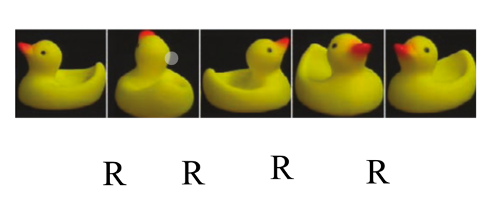
what are some general characteristics of our ability to classify objects (categorization)?
usually based on experience (prototypes) BUT ALSO
can be based on little or no experience (one-shot categorization)
how does categorization occur with experience? How do prototypes aid in this process?
i) although we haven’t seen all types of guitars, we recognize the common elements of different types of guitars and can categorize them into one group of the same object
i) for every category, there are prototypes (exemplars) that are more typically representative of that category
(1) having these prototypes in mind are good for identifying objects we have never seen
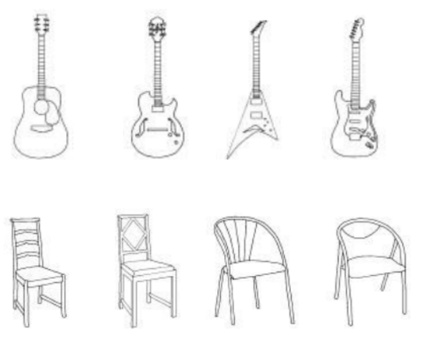
how might prototypes of dogs affect our thinking of different animals?
ex: different dogs that constitute the dog category (e.g. golden retrievers)
(a) in the chart (from slides), the peaks represent the prototypes
(b) but the categories include the less prototypical objects (dogs) as well
(c) objects from different categories overlap
(i) ex: the Komondor dog can overlap between the dog category as well as the sheep category
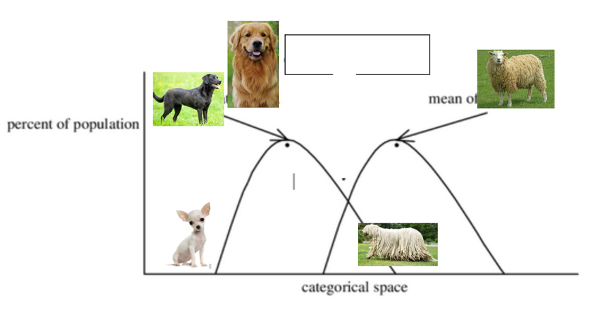
how does categorization occur when we have little or no experience? what is one-shot categorization highly dependent on?
through one-shot categorization; allows for inferences about a broader class of objects; filling in all other potential exemplars
(1) ex: shown one figure that looks like a pi sign, we’re able to immediately categorize 2 figures that look similar together (example from slides)
(a) we know the shape that is known as the pi-sign
(2) object categorization is highly dependent on SHAPE (rather than other features)
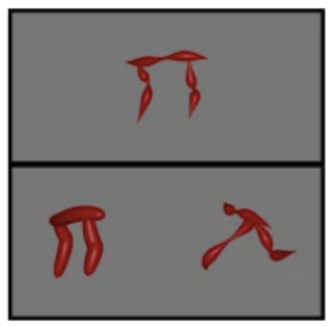
how does AI aid in categorization?
AI: built into machines to extract common elements from objects to categorize objects (not that advanced yet)
how did the thalidomide vs/ enantiomer crisis display humans’ tendency of left-right confusion? How does it affect our ability to recognize mirror-images?
ii) ex: in chemistry, students struggle to learn the distinction between molecules of the same proposition but mirrored
(1) thalidomide vs. enantiomer (chiral opposite)
thalidomide was prescribed to pregnant women in the 1960s to treat morning sickness
the antimer was also produced, pharmacists wouldn’t realize and prescribed women the antimer as well = the babies ended up with big deformities

what is left-right confusion and what default are we in when recognizing objects?
inability to accurately differentiate between left and right directions
since our default is to recognize objects as the same no matter their left-right orientation, we have to purposefully ignore the left-right ssues and treat objects as the same
how do we display intuitive physics?
i) we intuitively know the physical properties of the world
(1) ex: narrow rock tower, we know that it doesn’t fall bc it’s placed in a stable way

study at johns hopkins’ testing people’s intuitive physics: are adults’ intuition about object physics always right?
NO it can be wrong
(1) 2 circular figures, the arrow indicates the expected trajectory of the ball
(a) although the A trajectory was right, many students at Johns-Hopkins answered the B trajectory would occur
(b) = tendency to want to continue the same trajectory (like Gestalt principle of Good Continuation)
(1) our intuition can also lead us astray
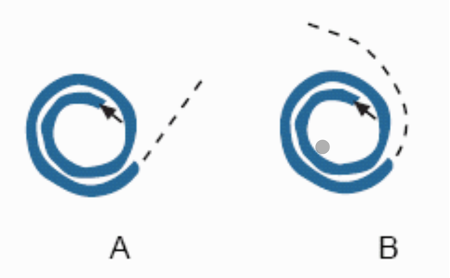
do infants discriminate between shape information from birth?
Yes; infants discriminate(visually) shape info without any experience, even when the stimuli (i.e. color and position) are very comparable
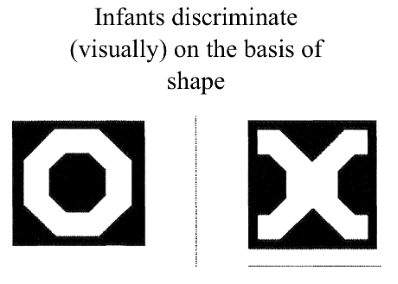
how is our ability to discriminate between shape information a representation constraint?
from the development of birth, our perception is constrained to think about the world in terms of shapes
infants show ________ shape matching:
infants show CROSS-MODAL(vision and oral) shape matching
from the first hours of life, the shaoe info we have in our minds is abstract, in some sense more cognitive than just perceptual
infants can carry out crossmodal integratin in that their intuition about how objects may feel when gapsed or what it would feel like if they put it into their mouth is similar to that of adults
study on babies with 2 different types of pacifiers: PROCEDURE
2 groups:
one sucking on pacifier that’s smooth
one sucking on pacifier with nubs/ridges
study based on babies’ preference for familiarity
study on babies with 2 different types of pacifiers: RESULTS
when a baby sucked on a nubby pacifier, they looked longer at the nubby pacifier
when a baby sucked on a smooth pacifier, they looked longer at the smooth pacifier
study on babies with 2 different types of pacifiers: CONCLUSION
infants show cross-modal shape matching (between vision and oral)
study on babies with 2 different types of pacifiers: ALTERNATE STUDY
other study that made babies look a the different pacifiers first led to babies choosing to suck on the pacifier they looked at initially
by 3 months of age, infants use shapes for _________
by 3 months of age, infants use shapes for CATEGORIZATION
habituation/dishabituation study on infants with variations of triangle: PROCEDURE & RESULTS
(1) habituated them to items; not typical triangles, but they all shared the triangle-like shape
(2) then showed infants familiar object (triangle) & novel object (e.g. square)
(3) RESULT: babies were able to do categorization of shapes by 3 months because they looked at the novel object (square) longer
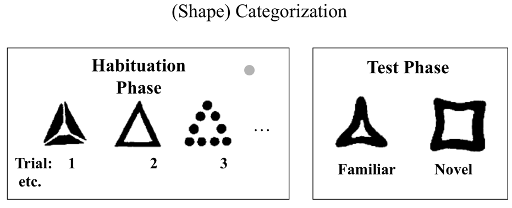
by 6 months of age, infants possess _________
by 6 months of age, infants possess viewpoint invariance
study on viewpoint invariance on 6-mo-olds: PROCEDURE & RESULTS
(1) one set of babies habituated to one set of perspectives of an object
(2) in the test trial
show completely different perspective of the same object
OR a completely different object that was not introduced before
(3) they looked longer at the never-seen object = violation of expectation = by 6 months
infants showed viewpoint invariance at 6 months-old
color did not affect infants’ choice because the test trial objects were both objects with a color that the infants had not seen before
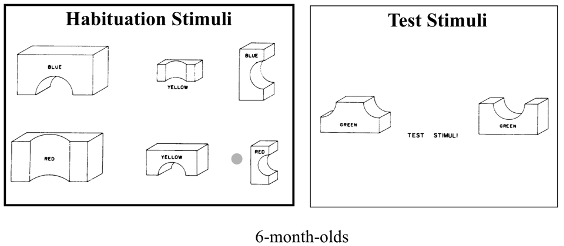
is viewpoint invariance innate? what study demonstrated an answer to this?
yes it may be innate; study on newborn chicks
study of newborn chicks’ viewpoint invariance: PROCEDURE
(a) chicks who don’t have any experience with objects in the world
(b) present them with virtual objects (called starship enterprise)
(c) the virtual object supposed to be the chicks’ “mother” bc the chicks imprint to the object
(d) BUT the chicks only ever saw the object from a single perspective.
(e) then present chicks with wide viewpoint ranges of 2 objects:
imprinted/familiar object
unfamiliar object
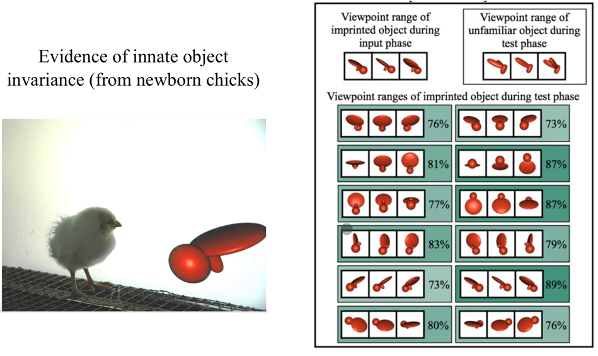
study of newborn chicks’ viewpoint invariance: RESULTS
(i) the chicks followed around the imprinted/familiar object although they were shown in all kinds of different orientations than they first imprinted on
chicks spent more than 50% with the imprinted object (if less than 50%, they did not display object invariance)
study of newborn chicks’ viewpoint invariance: CONCLUSION
newborn chicks displayed object invariance, which means this ability may be innate in organisms, including human infants
what are the 2 benefits of object invariance?
(1) we are not stumped by different orientations of the same objects
(2) it’s useful in cases with simpler stimuli
what are the 2 cons of object invariance?
(1) not discriminating between objects of different LEFT-RIGHT orientation
as in the example of thalidomide vs. enantiomer leading to destructive consequences
(2) READING requires us to override our object invariance
how does learning to READ require us to override our object invariance ability?
(a) learning to read (and write) requires that we override our (automatic) ability to engage in object invariance
kids make spelling errors bc they can’t differentiate between ‘b’ and ‘d’
(b) we cannot read mirror writing easily
(c) reading is especially challenging for kids because humans need to get past our natural tendencies of reading (as writing was invented by humans)
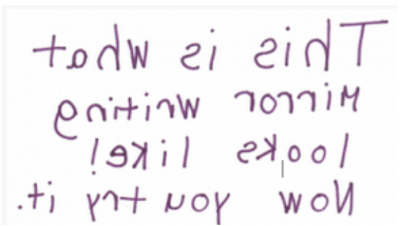
study on infant discrimination of left vs. right: PROCEDURE
(1) in habituation, show infants a shape on the left side of a vertical line (the marker), showing up on different parts of the screen

study on infant discrimination of left vs. right: RESULTS
(1) after babies were habituated, they look longer at the object at the right side of the line (novel object) during test trials
study on infant discrimination of left vs. right: RERUN
(1) show a shape on the left side with no vertical line
(a) babies differentiated even without the vertical line marker
(b) babies know that things on the left vs. right are different

study on infant discrimination of left vs. right: CONCLUSION
(1) babies can tell the difference between left-right = perception is in tact
(2) but the REASONING about left-right differences is the difficult part = cognitive system is not up to speed with the perceptive system
do children know depth and height (distance)? what study demonstrated the answer to this?
Yes; visual cliff experiments
visual cliff experiment: PROCEDURE
(1) Big box w/ transparent glass and patterned board side
(a) Made parent beckon the child to cross over beyond the “cliff”
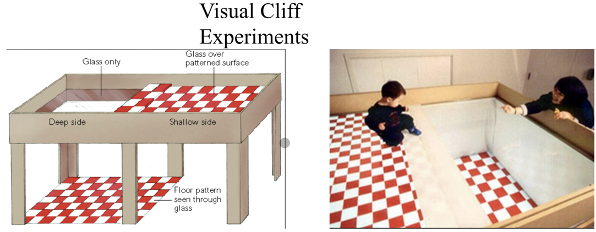
visual cliff experiment: RESULTS
(a) sometimes babies who were placed on the center used their leg to test if it’s an actual cliff (the leg “falls over” to the deep side, the leg is still stable on the glass, their body tries to tell them that it’s not an actual cliff)
even though children feel the platform, they still do not cross over to the deep side
(b) whether or not children cross over depended on crawling experience
at minimum, you need to test babies that have been crawling for at least some time
visual cliff experiment: CONCLUSION
(1) the babies understand depth, differences in distance
(i) the visual system is so sensitive that even though the babies felt that it wasn’t a cliff (with their leg), they still don’t cross over to the deep side
(b) independent locomotion may be really important in building this understanding of depth & distance
(i) this leads to studying infants’ understanding of depth, but taking out movement
do infants need experience to understand distance/depth? what do they understand distance by then?
No; they understand distance by OBJECT MOTION and PICTORIAL CUES even without experience
study on infants’ understanding of distance/depth by object motion: PROCEDURE
i) set a contraption that move moves object closer or further away from baby
Q: when baby is sitting on a chair and an object is moving toward them, are infants aware that it’s moving toward them?
see whether they blink (test for a blink that’s titrated to the movement of the object)

study on infants’ understanding of distance/depth by object motion: RESULTS
infants blinked right when the object was about to hit them
study on infants’ understanding of distance/depth by object motion: CONCLUSION
i) infants understand depth, especially in regards to its relation with their own physical bodies
some other studies tested for swerving of the body, backwards movement of the head(flinching)
experiment on ducks’ understanding of distance/depth by pictorial cues (2D images): PROCEDURE
(1) infant sat in front of a board, on the board was plastered a 2D image that included pictorial info about the distance (converging lines), the image simulated a table
(2) on the image were 2 ducks
on the retina, the 2 ducks are the same size, size of the ducks cannot infer distance to us
there was no visual info related to duck size to infer distance, the only factor of inference for the infants was the converging lines of the image
(1) the infant was put in between the 2 Velcro ducks
see which duck the infant reaches out to
prediction: the infant will reach out to a duck that appears closer to them
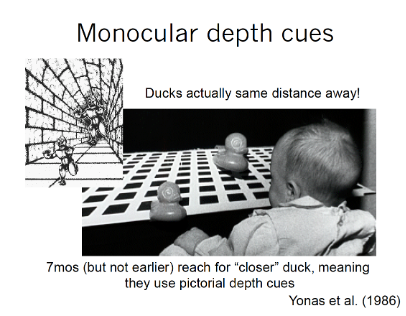
experiment on ducks’ understanding of distance/depth by pictorial cues (2D images): RESULT
(a) the infant reached out to the duck that was “closer” to them, at the upfront of the converging lines (the more up the duck was on the converging lines, the “further way” the duck was)
experiment on ducks’ understanding of distance/depth by pictorial cues (2D images): CONCLUSION
(a) infants understand distance by pictorial cues, even without looking at the size of the object itself or using their own bodies to test for depth
human visual system is set up to do this from birth
(b) there is still some sensitivity to the environment even before crawling begins
if infants can understand distance without experience, then does locomotion not help infants? what are the other effects of crawling experience in determining their actions?
a) fear of consequences motivate us to act/move in certain ways
ex: when we’re not afraid of falling, then we will take the step off the cliff
i) babies step in the walker before being able to officially walk
seems to speed up the development of walking, build locomotory experience
ii) Q: can we give babies with no crawling experience walker to see if they can step?
what’s the role of locomotory experience?
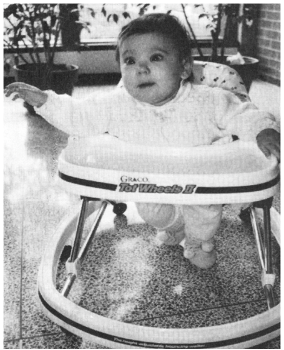
visual cliff experiment on babies with walker experience vs. babies with no walker experience: PROCEDURE
i) participants: infants with little walking experience
recent crawlers
‘walker’ condition —> some walking experience
(1) measures:
(a) movement to one side or the other (standard measure)
(b) placing response (i.e. extension of arms and hands)
when babies are put on the shallow side vs. the deep side (by being held on the sides of their stomachs by adults)
there should not be extension of the limbs on the deep side since they wouldn’t think they’re actually landing, they will keep their legs together
ii) measured heart rate responses during descent
visual cliff experiment on babies with walker experience vs. babies with no walker experience: RESULTS
(1) standard measure:
children with little locomotory experienced crossed over to the deep side more than children in the walker condition
suggested that crawling experience matters
(2) placing response
both groups of children placed in accordance with depth
when babies were placed on the deep side, they kept their legs together and did not extend
= experience does not affect their visual ability
(3) heart rate during descent
children with little locomotory experience showed no change; they saw the difference, understand that it affects their body placement, but they didn’t seem to care = not considering consequences
children in walker condition showed increased heart rate; children develop understanding of consequences of their actions/movements as they develop their independent locomotory abilities
visual cliff experiment on babies with walker experience vs. babies with no walker experience: CONCLUSION
i) locomotory experience matters—not for depth perception—but for determining a fear response
but it would be an oversimplification to say fear and perception do not work together
there are also conditions where perception and fear can go together – when fearful ppl are placed in a room of spiders and snakes, they feel that the snakes and spiders are bigger than the ppl who are not fearful of spiders and snakes
Baillargeon’s drawbridge experiment testing object permanence on 3-mo-olds using VOE: PROCEDURE
infants were habituated to the sight of a screen rotating through 180°. a block of wood was placed in the path of the drawbridge.
the control group saw the expected event, in which the drawbridge stopped at the point where its path was blocked by the block.
the experimental group saw the unexpected event, in which the drawbridge appeared to pass through the block and ended up lying flat.
(6) prediction: if infant understands object permanence, infant should look longer at the impossible event
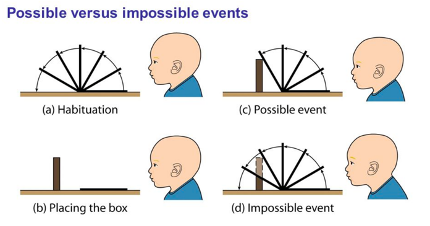
Baillargeon’s drawbridge experiment testing object permanence on 3-mo-olds using VOE: RESULTS
infants spent much longer looking at the unexpected event. this indicated surprise on the infants' part as they had expectations about the behavior of physical objects that the unexpected event had violated.

Baillargeon’s drawbridge experiment testing object permanence on 3-mo-olds using VOE: CONCLUSION
infants understood that the object continued to exist (when occluded)
the infants knew that the box still existed behind the drawbridge (thus demonstrating object permanence) and that one solid object cannot just pass through another.
infants understand both solidity and object permanence by 3-mo
Baillargeon’s drawbridge experiment testing object permanence on 3-mo-olds using VOE: LIMITATIONS OF THE INITIAL STUDY & EXPLANATION
infants may have gotten habituated to the moving drawbridge (habituation/dishabituation took place, infants got bored of the moving drawbridge)
it would not just be about object permanence
A: even with this proposition, they will still look longer at the possible event, since they will look to the new interesting not-moving drawbridge
Baillargeon’s drawbridge experiment testing object permanence on 3-mo-olds using VOE: RERUN & RESULT
(1) to account for the possibility of habituation/dishabituation taking place, Baillargeon got rid of the box
now the impossible event became the bridge stopping mid-air
(a) across trials, the babies did not look significantly longer at one event over another one
Baillargeon’s drawbridge experiment testing object permanence on 3-mo-olds using VOE: LIMITATION
(a) what if the object behind the drawbridge changes?
(b) unlike older children and adults, infants do not react even when the object changed mid-experiment
(c) that is, although they understand that an object continues to exist, they do not encode the identity of the object per se
(i) it’s more about the object, than what the object is
summary of Baillargeon article: what do infants know about objects?
a) young infants may have some understanding of permanence but not across all occlusion events (refer to reading from this week)
b) infants understand solidity, but not all contact-related trajectories (e.g. contact by a big object vs. small object results in different displacement)
c) infants understand support/gravity but the precision of this understanding develops over the first year of life (e.g. amount of contact)
i) by 3 months, they start understanding that there should be some kind of contact for an object to stay on top of another contact
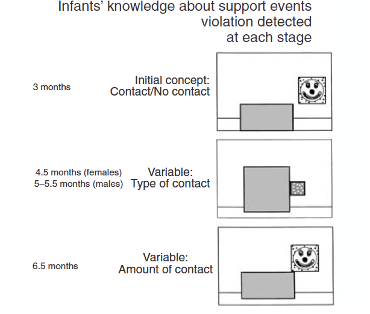
Baillargeon’s ramp experiment testing whether surprise promotes learning: PROCEDURE
a) knocking on wood block to show that it’s solid , making it stand up at the bottom of a declining ramp, put barrier to infant’s view of the wood block, make toy car roll down the decline
showed babies 2 different events:
(1) matches expectation: stop at the wooden barrier
(2) violates expectation: goes through the wooden barrier and ends up behind the wooden barrier
Baillargeon’s ramp experiment testing whether surprise promotes learning: RESULTS
a) spent more time looking at the VOE event and even displayed behavior like knocking the object on other surfaces to test for solidity
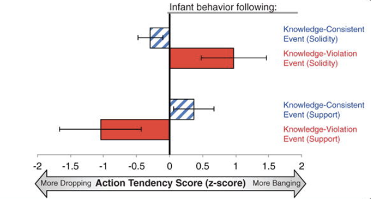
Baillargeon’s ramp experiment testing whether surprise promotes learning: CONCLUSION
surprise promoted learning; infants try to test their knowledge (i.e. infants knocked the object on hard surfaces to test for solidity)
Baillargeon’s support violation pheomenon: PREDICTION & RESULTS
i) expected: when object goes off a surface, it falls
ii) VOE: object remains suspended mid-air after it falls off the surface
iii) RESULTS: babies who see the VOE spent more time looking at that object than babies in the other case, AND they interact with the object that suggests they try to understand the phenomenon
(1) tries dropping the object to see what happens
physical reasoning about support ability: by 6.5 months of age, infants understand the relation between ____ and _______
infants understand about size and contact by 6.5-mo
they look longer to the impossible event where an object stays stable even when pushed off because they expect it to fall off
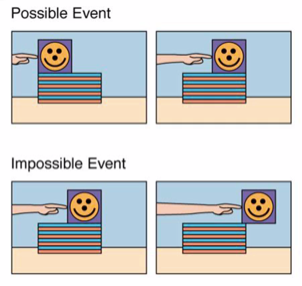
Further tests on object knowledge by Baillargeon using one screen to occlude 2 objects
hide 2 objects behind one screen, show teddy bear coming out of the screen first, hide it, then show duck
i) at 6 months, infants don’t seem to expect 2 objects, they look equally at both test trials
ii) by 12 months, they understand that there are 2 diff objects in this scenario
(1) they look longer at the test display with one object
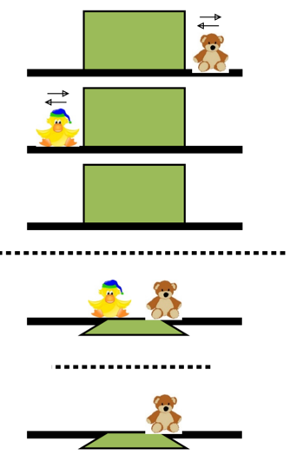
Further tests on object knowledge by Baillargeon using 2 different screen to occlude 2 objects
i) at 6 mo, infants look longer to the test display with 1 teddy bear
(1) suggesting that they expect 2 different teddy bears exist
even though the teddy bears are identical, the 2 distinct locations (screens) seem to help infants understand the different (though identical) objects
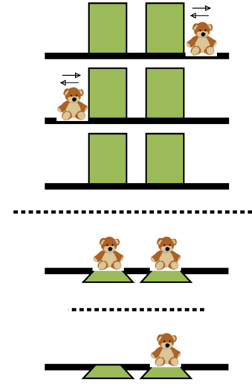
what would piaget say about infants’ object knowledge?
a) Visual discrimination of diff object properties (e.g. shape) is NOT mature object knowledge
b) Knowledge of objects includes interactions with objects (that is, how to interact with them)
c) Knowledge of objects includes their existence independent of location (recall A-not-B error)
do infants understand object permanence prior to the end of the sensorimotor stage according to later studies like those by baillargeon?
a) Contrary to Piaget, visual attention paradigms suggest they do!
b) VOE (and visual tracking) also suggest that infants understand other object properties (prior to the end of the sensorimotor period)
Solidity
Trajectory of movement
Support (i.e. gravity)
example on perceived trustworthiness of 2 computer-generated faces:
(a) on average people chose the face on the left
(2) there is consistent bias in people’s answers to perceiving faces
(3) we are readily making these automatic assumptions based on these faces, in ways we don’t do for other objects
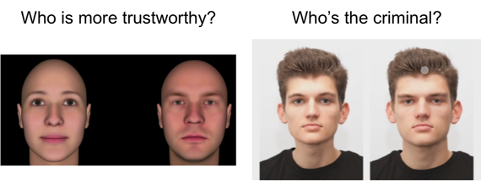
is attention more readily drawn to faces than other objects?
YES
(1) our attention is drawn more automatically to objects that are a face than objects that are not a face
(2) example in the slides: adults are faster to detect the single face (in the display of objects) than the single object (in the display of faces)
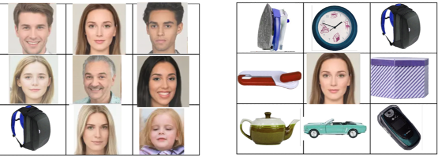
difference between people on the autism spectrum disorder & non-ASD people in eye tracking: attention to general environment
(a) when asked to look at the images, people with ASD vs. control group fixated on different objects
(i) ASD: autism-spectrum-disorder; they spent less time looking at the faces and more time looking at the sign = their attention is not grabbed by faces like people without autism do
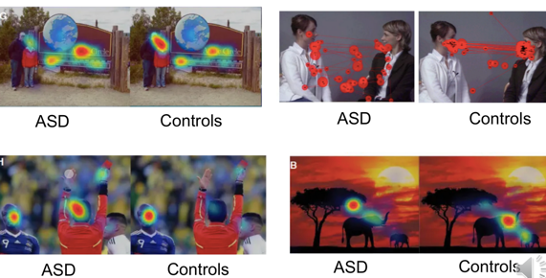
difference between people on the autism spectrum disorder & non-ASD people in eye tracking: attention to interaction of 2 people talking
ASD people looked all over the people while non-ASD people focused more on the faces (lips)
difference between people on the autism spectrum disorder & non-ASD people in eye tracking: attention to front of head vs. back of head
ASD people looked longer at the back of the head while control group looked a lot less to the back of head and more to the front of head
difference between people on the autism spectrum disorder & non-ASD people in eye tracking: animals
ASD people didn’t look at the animals’ faces as much as the control group did
overall, do we attend more to faces than other objects from infancy?
YES; same between 3 months and 6 month-olds
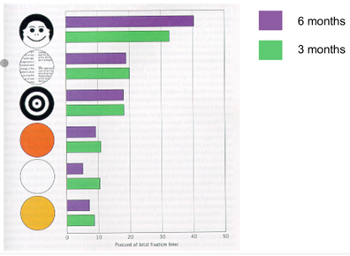
what is pareidolia?
the tendency to perceive a specific, often meaningful image in a random or amboguous visual pattern
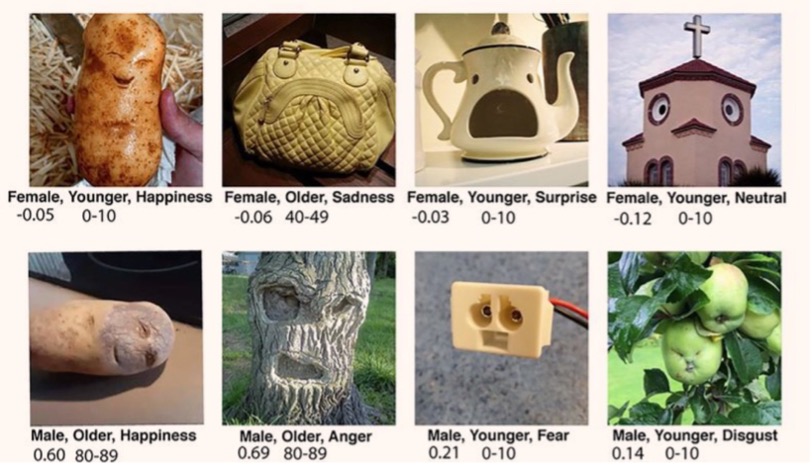
what is the face inversion effect?
we make more errors and are slower in detecting faces when they’re inverted than right-side up
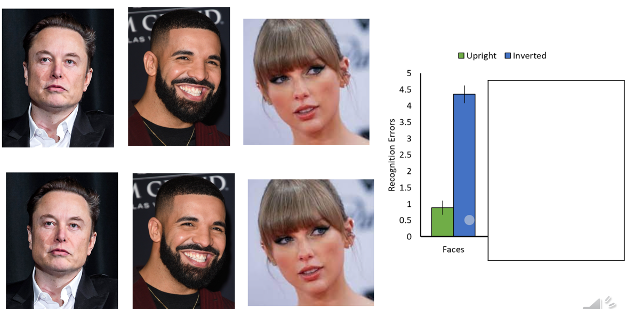
does the inversion effect also influence our detection of objects to the extent it influences us when detecting faces?
NO; there’s a lesser effect on objects
invariance in objects = we can identify objects in different orientations
eceptions:
less recognition erros for some objects like airplans, houses
i) shows categorical/qualitative difference between faces and other objects?
(1) yes: when faces are compared to airplanes, it does seem like a qualitative difference
(2) & no: when faces are compared to houses, performance had a less significant difference

what is the thatcher effect?
phenomenon where it becomes more difficult to detect local feature changes in an upside-down face, despite identical changes being obvious in an upright face
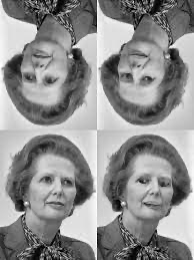
what does the thatcher effect in combination with the face inversion effect suggest about the difference in representations of faces vs. objects?
i) suggests a qualitatively different representation for faces compared to objects
(1) in objects, the inverted parts are more immediately noticeable to us
what is a possible explanation for why we get tricked by the thatcher effect & face inversion effect?
i) in general, the interpretation is that faces are perceived more holistically than other objects
(1) processing of faces is holistic – entire scene is considered
what type of people are less likely to be influenced by the face inversion effect and thatcher effect?
i) professionals aren’t really influenced by inversion effects and thatcher effect in the stimuli that they’ve mastered the knowledge in (they don’t notice the inversion)
(1) when we become expert at anything, we may recruit a more holistic processing
(2) holistic processing will apply to other objects/ not just faces, when we gain more expertise on it
how does the Fusiform Face Area (FFA) act as evidence that face-processing is a domian-specific system?
study using fMRI machine, observed where the blood flow increases when processing faces
ii) showed participants bunch of faces (not just human faces)
RESULTS:
one brain region—Fusiform Face Area (FFA)— is more involved in face processing
more activation in the right hemisphere than in the left hemisphere
percent signal change in FFA (blood flow change) was highest in faces compared to cars, houses, textures, etc
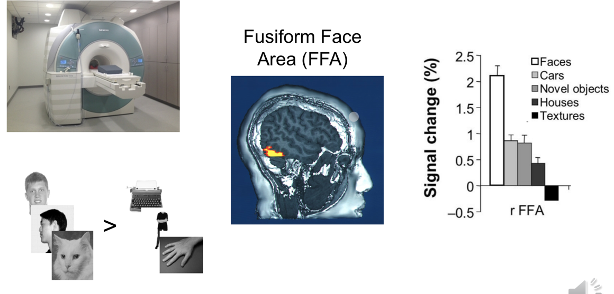
what does damage to the Fusiform Face Area lead to?
prosopagnosia: aka ‘face blindness’ though there is nothing wrong with vision, inability to recognize faces (specifically faces, not other objects)
(a) ex: can’t tell one person apart from another person
(b) could be development or acquired (from strokes or tumor)
shows that face-processing a domain-specific system since patients with prosopagnosia didn’t show similar activation in FFA as typical individuals, which meant that brain region had been affected
Could be FFA that’s affected
Could be hurting holistic processing
Doesn’t impact emotion recognition, implying separate processing

what brain region is specialized for reading?
(1) visual word form area (VWFA): brain region becomes very specialized in detecting letters and words compared to other objects and faces (shown in fMRI)
(a) VWFA is very close to FFA
what did the study on illiterate individuals from Portugal find out about their VWFA?
(a) scanned their brain regions, they had FFA but not VWFA
(b) taught them how to read, scanned their brains after, they found that VWFA had started to take over FFA (FFA was smaller and less active)
(c) then led to the question: is there a closer association between processing words & faces?
(i) neurally there’s a difference
(ii) but behaviorally, we don’t know as of yet
(iii) something that seems as dissimilar as faces and words even has some association
infants show a preference for top-heavy objects from birth. What does this convey about the development of their face processing abilities and if humans have an innate preference for faces?
i) when infants are shown an image that looks like a face, infants will looked longer at a face compared to the scrambled image (parts of face are scrambled)
ii) infants will also look longer at an image with top-heavy image that has similar boundaries of a face, than a bottom-heavy image
a) this suggests…infants may not have an innate preference for faces, but it may be the more low-level preferences of infants that just relate to faces
there is an innate face-like template, rather than a representation of real-life faces, per se
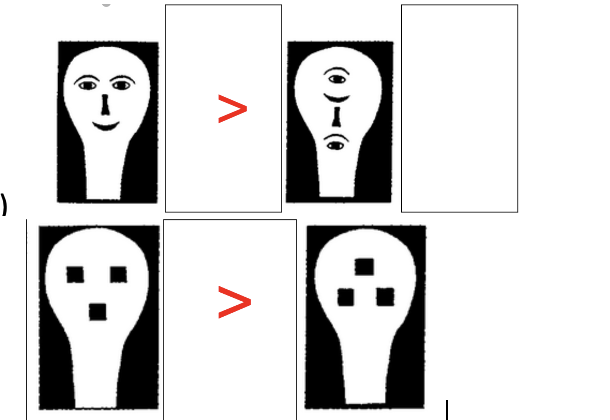
ultimate research with modified stimuli to test for what infants innately prefer: experiment #1
upright face vs. upside-down face
babies spent more time looking at the upright face than upside-down face
= infants may innately process faces and they may even show the inversion effect BUT ALSO it may be a top-heaviness vs. bottom-heaviness preference
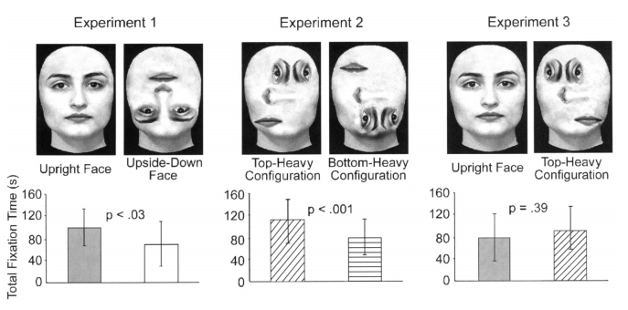
ultimate research with modified stimuli to test for what infants innately prefer: experiment #2
i) showed images with atypical arrangement of facial elements
(1) infants looked longer to the top-heavy configuration (with eyes at the top) than the bottom-heavy configuration
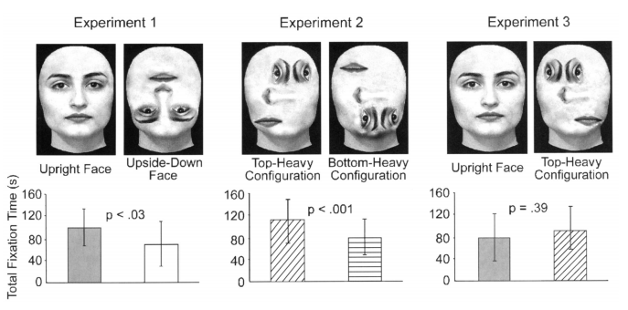
ultimate research with modified stimuli to test for what infants innately prefer: experiment #3
showed images of a typical upright face vs. a top-heavy configuration with atypical facial elements
(1) there was no significant different between looking time
(2) if it was just face processing, they would discriminate between the 2 images
ultimate research with modified stimuli to test for what infants innately prefer: CONCLUSION
infants showed preference for top-heavy figure even when it had atypical arrnagements of facial features= it is something more general about top-heaviness preference and not just preference for faces
study on fetuses’ head movement in response to a projected topy-heavy vs. bottom-heavy images: PROCEDURE
i) scan which direction the fetus is in a pregnant woman, project info through uterine wall
ii) fetuses aren’t typically seeing anything
iii) when projected with face-like stimuli (top-heavy) vs. bottom-heavy, do fetuses move their head toward the a distinct stimuli?
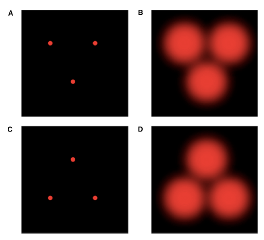
study on fetuses’ head movement in response to a projected topy-heavy vs. bottom-heavy images: RESULT
fetuses moved their head toward the face-like, top-heavy stimuli longer than they had their head turned away
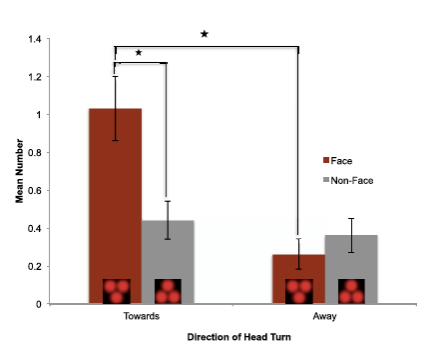
study on fetuses’ head movement in response to a projected topy-heavy vs. bottom-heavy images: CONCLUSION
i) face-like,top-heavy template is present even before birth, is truly innate
infants with cataracts do show some deficits in face processing even following cataract removal. what does this convey about how mucb expereince is needed for understanding faces?
i) if (face processing) is an innate ability, then experience should not be relevant
BUT there are certain kinds of face processes that do depend on experience
orientation changes- infants who previously had cataracts have a harder time recognizing faces at different orientations
lighting change- infants who previously had cataracts have a harder time recognizing faces after lighting change
ii) thus, exposure to faces may be needed for some types of discrimination/face processing is not entirely innate
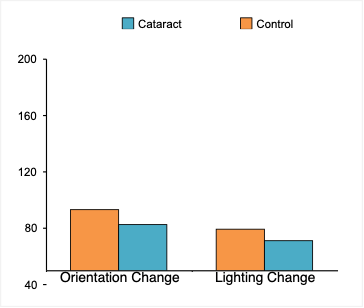
in the general timeline of infants’ face processing abilities, what do infant show at birth?
birth:
preference for face-like pattern (top heaviness)
preference for attractiveness
preference for mother vs. another woman

in the general timeline of infants’ face processing abilities, what do infant show at 3 months?
preference for own race
preference for gender of caregiver
(not just the primary caregiver anymore but anyone who is of the same gender)
discrimination of emotional expressions
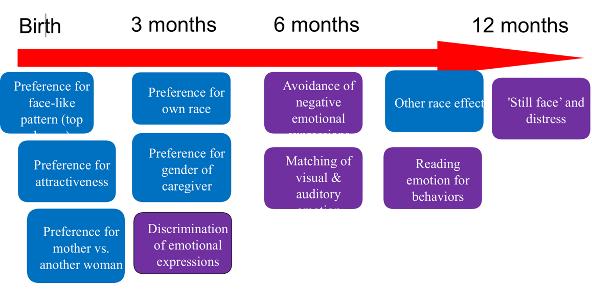
in the general timeline of infants’ face processing abilities, what do infant show at 6 months?
avoidance of negative emotional expressions
matching of visual & auditory stimuli
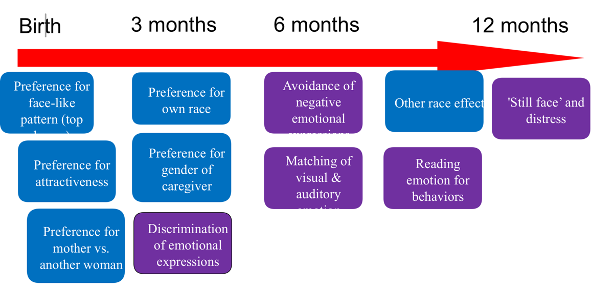
in the general timeline of infants’ face processing abilities, what do infant show between 6 and 12 months?
other race effect
reading emotion for behaviors
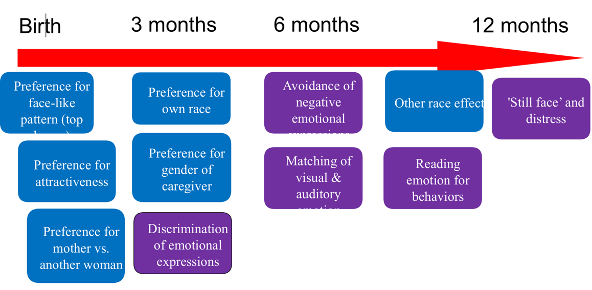
in the general timeline of infants’ face processing abilities, what do infant show at 12 months?
‘still face’ and distress

according to the preferential looking paradigm, do infants prefer more attrative faces? what age is this observed?
YES at around 1 month old; for both humans and animals